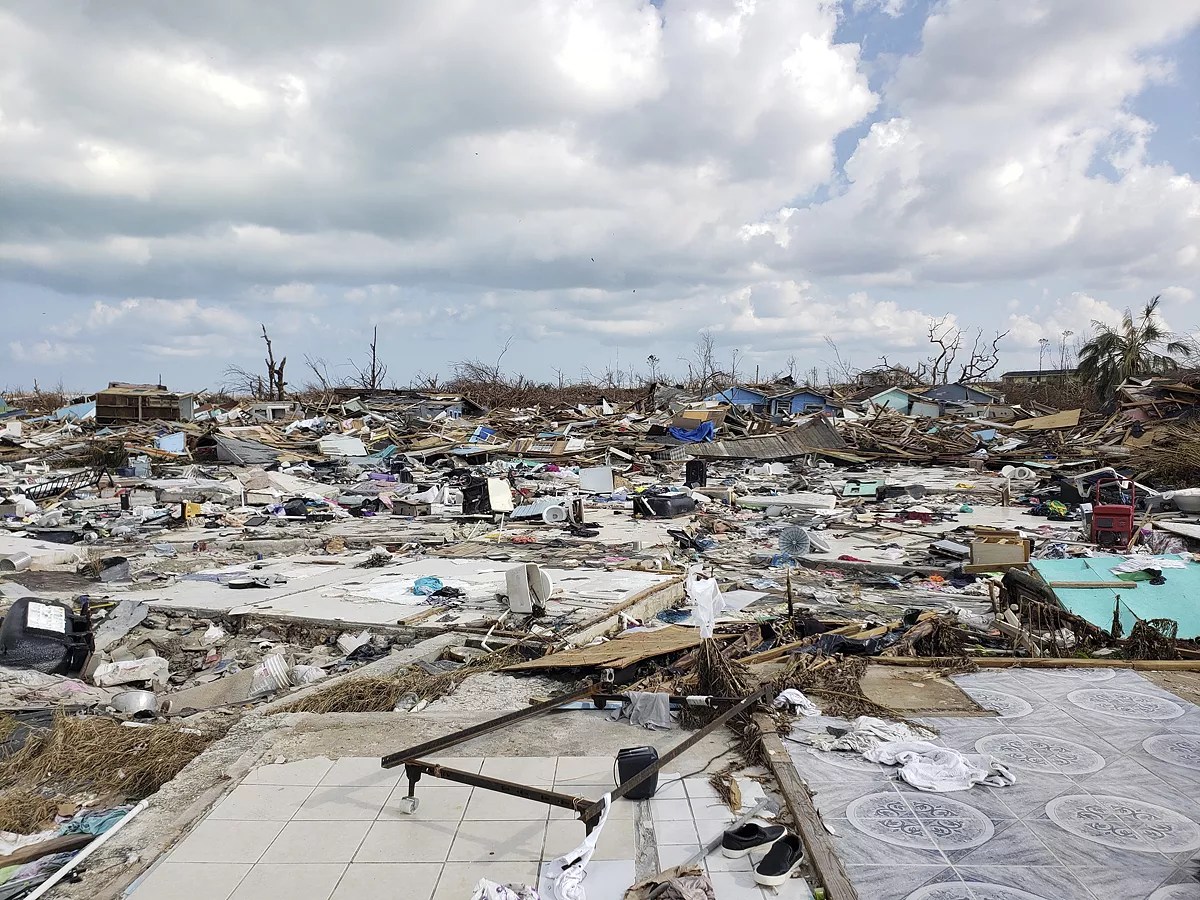
Photo by Zachary Fagenson

Audio By Carbonatix
The devastation on Great Abaco wasn’t apparent at first.
While the pilot we’d paid $1,300 for the 45-minute flight from Nassau began the plane’s descent, the teal-and-cobalt Atlantic gave way to vast expanses of jagged green spits bordering shallow, sandy lagoons. A grounded boat lying on its side some 500 yards inland was the first indication of what was to come. The landscape shifted from green to a deathly brown, all the trees stripped of their foliage. The first houses – or what once had been houses – came into view. Most were smashed, leaving only roof sections and chunks of siding clumped together in big piles. Full-size shipping containers were strewn about like dented, discarded soda cans.
Five days after Hurricane Dorian stalled over the Abacos and nearby Grand Bahama, pummeling the islands for 24 hours with its 185 mph winds, the runway of the Leonard M. Thompson International Airport had been cleared. But the buildings that ringed the landing strip had been ripped open like Christmas presents. The control tower remained upright, but the attached office building was stripped to its skeleton. Once our twin-prop six-seater touched down, I realized the airstrip was being operated by U.S. Navy personnel who were orchestrating the traffic from the tarmac via radios.
The strangest sight: Blackhawk helicopters, C-130 Hercules transport planes, and untold millions’ worth of gleaming Gulfstream jets parked scant steps from hundreds of people who, having made it this far, had no idea when – or whether – they’d be able to get out.
“I don’t know where I’m going to go – no idea. Maybe somewhere where I can have a job, but who knows,” said Benghy Delotte, a 35-year-old carpenter who’d been waiting outside the airport for four days with scarcely any food or water. “We’ve had to survive on our own. Whatever we find on the ground is what we eat.”
Delotte and several dozen other men were clustered outside the airport’s powder-blue-trimmed main terminal. Women and children had been allowed inside, where they’d transformed the space into a musty shelter ripe with the stink of dirty diapers. The security checkpoint had all but lost its former identity: A conveyor belt that once scanned the luggage of moneyed tourists had become a triage station littered with discarded medical supplies; the cafeteria was the domain of a burgeoning swarm of flies.
In stark contrast to Delotte, my three fellow travelers and I were well equipped. We had clean clothes. Our employer, Reuters news service, had outfitted us with plenty of water, ready-to-eat meals, mountains of batteries, portable solar panels, powdered electrolytes, and fruit juice. We had cigarettes, mesh bug nets, camera equipment, functioning smartphones, and portable satellite dishes to beam back images and interviews from the aftermath.
For the next three days, it would be our discomfiting task to point our recording equipment at piles of rubble that days earlier had been houses, and to extract stories from the occupants who’d abandoned them to the hurricane, who now were reduced to convulsive sobs at the sight of what had become of their homes and their lives.
When I deplaned in the tourist-thronged capital of Nassau late the previous afternoon, September 5, the Holiday Inn Express on Bay Street across from Junkanoo Beach was already one of the de facto headquarters for personnel arriving on behalf of relief agencies and news organizations. The lobby bustled with blue-vested United Nations workers; the thumping of Dutch, Canadian, and U.S. military boots; and the chatter of Japanese, French, Italian, and Mexican journalists.
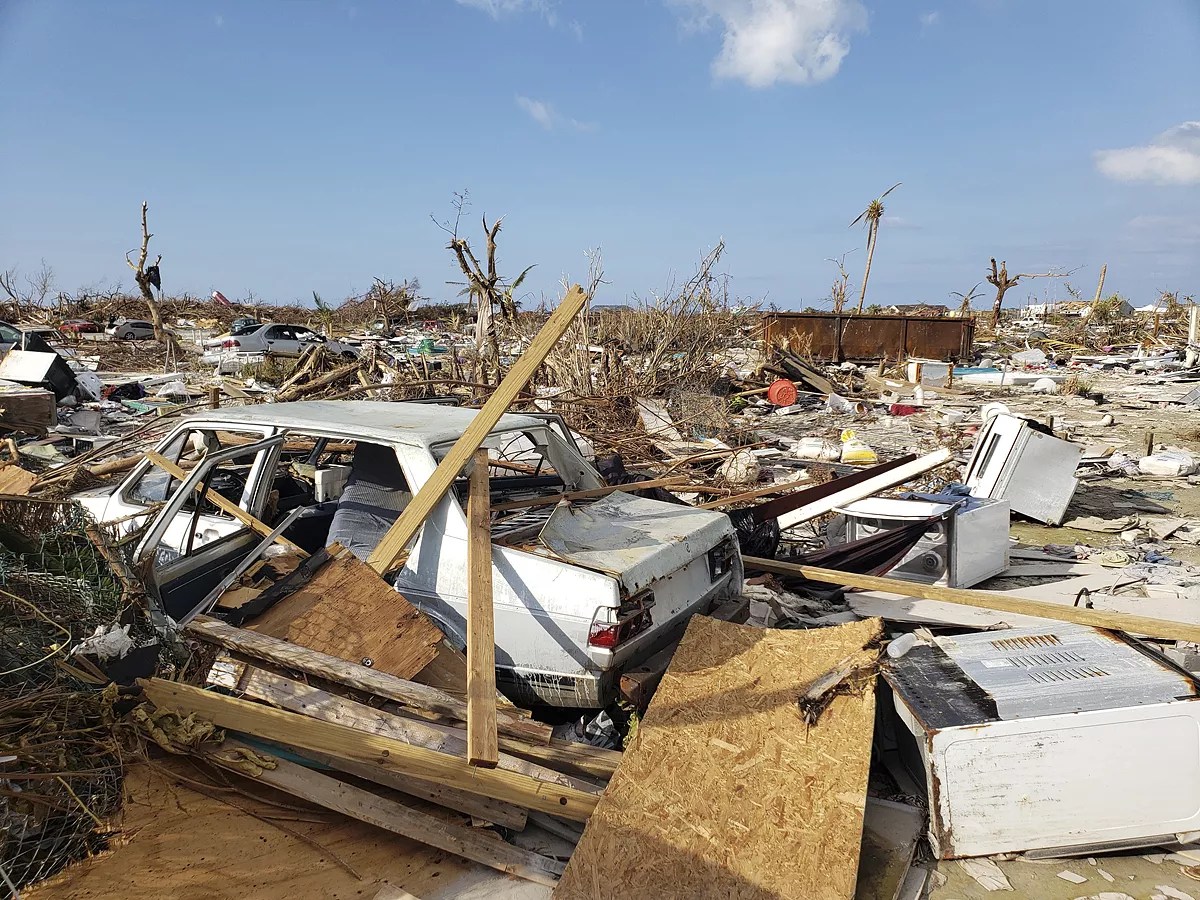
Crushed cars on the edge of the mostly Haitian shantytown called the Mudd. See more photos of the destruction on the Abaco Islands after Hurricane Dorian here.
Photo by Zachary Fagenson
The 700 islands that compose the Bahamas archipelago dot a swath the size of Texas in the western Atlantic Ocean. (Bimini is closest to the U.S. mainland, about 70 miles southeast of Miami.) Dorian had spared all but two of the former British colony’s 16 major islands: Grand Bahama, where the city of Freeport is located, was hit hard, while Great Abaco was nearly obliterated – the United Nations World Food Programme (WFP) estimated 90 percent of that island’s structures were destroyed. According to the WFP, 70,000 people were in need of housing and shelter on the two islands, respectively the second- and third-most-popular tourist destinations in the Bahamas. Nassau, meanwhile, remained a veritable Disneyland, with cruise ships arriving and departing regularly.
My plan was to board a charter to Great Abaco the next morning. But the promised plane didn’t materialize. Nor did a helicopter service that had accepted a $5,000 wire transfer for two rides.
Marooned in Nassau, I walked to Princess Margaret Hospital, a pastel-yellow complex styled in the imposing manner of the country’s onetime British colonial overlords and the only large medical facility in the Bahamas that was fully functioning after the storm. Victims had begun arriving the day before, yet the lobby was eerily calm. I found Leon Lazard, a 42-year-old contractor from Abaco who’d been airlifted in after he was injured while rescuing his mentally handicapped brother Lawrence. Lazard and about 30 others had been caught for hours in a horrifying relay race, running from one flooded house to another, fleeing each as the winds ripped off roof after roof.
“Every time we tried to go outside, the weather would show its might,” Lazard said, speaking quietly while staring off into the distance. “It would pick up something and throw it at us – like it was saying, ‘If you come out here, all of you are dead.'”
As Leon clung to his brother in the rafters of one house, the winds began to pull Lawrence from his arms. Leon’s foot became wedged in the roof’s beams, which snapped and broke his ankle, peeling back the skin all the way to the bone. Somehow both men made it to a shelter, where Lawrence remained after Leon was airlifted out.
A hospital employee demanded I sign a release limiting the kinds of questions I could ask and forbidding me to publish certain information before letting me interview any other patients – only the first of several interactions in which officials would attempt to control the flow of information. But Dr. Caroline Burnett-Garraway, the hospital’s medical chief of staff, was more forthcoming. She told me that the government had yet to formulate a plan to deal with the dead bodies believed to be on Great and Little Abaco, and that two refrigerated 40-foot containers were en route to Grand Bahama by boat to serve as a temporary morgue. She must have realized she’d said too much; I wasn’t able to get ahold of her again.
The rest of the day was an unwelcome education in dealing with the government. A scheduled meeting with representatives of the myriad nongovernmental organizations working on the islands withered after government officials failed to show up, leaving everyone standing around in an empty ballroom. I heard about a news conference with the head of the Bahamas’ National Emergency Management (NEMA) and trekked up the road to its small pink headquarters, only to learn that the proceedings had already taken place behind closed doors.
The building brimmed with people looking for family members, who were offered little more than the addition of the names of the missing to a pen-and-paper list. Evacuations by air had begun; a NEMA employee told me that 200 people had been flown out. At that time, the national carrier, Bahamasair, was offering its empty seats on flights off the island for $75 – a controversial charge that was later rescinded.
When we finally reached Great Abaco the next day, one of my colleagues found us a ride in a burgundy pickup captained by a heavyset Haitian who introduced himself as Pasteur. We were headed to a hotel, I was told as I threw my bags into the truck bed and jumped in.
From the air, Marsh Harbour had appeared to be a small town. On the ground, it was an endless wasteland, stripped of street signs, landmarks, and buildings. The denuded landscape induced a kind of horizontal vertigo that left locals and interlopers alike disoriented.
Complicating matters were downed trees and power lines. And broken roads: At multiple intersections, Pasteur had to back up and turn around, the concrete slabs that once made a smooth junction between converging roads having been lifted by wind and water and deposited elsewhere. Eventually, we arrived at what was left of the Abaco Beach Resort, formerly a sprawling seaside oasis complete with a glittering marina, now tattered and seemingly abandoned. No boats in the water, only torn tree limbs jutting up like bony fingers.
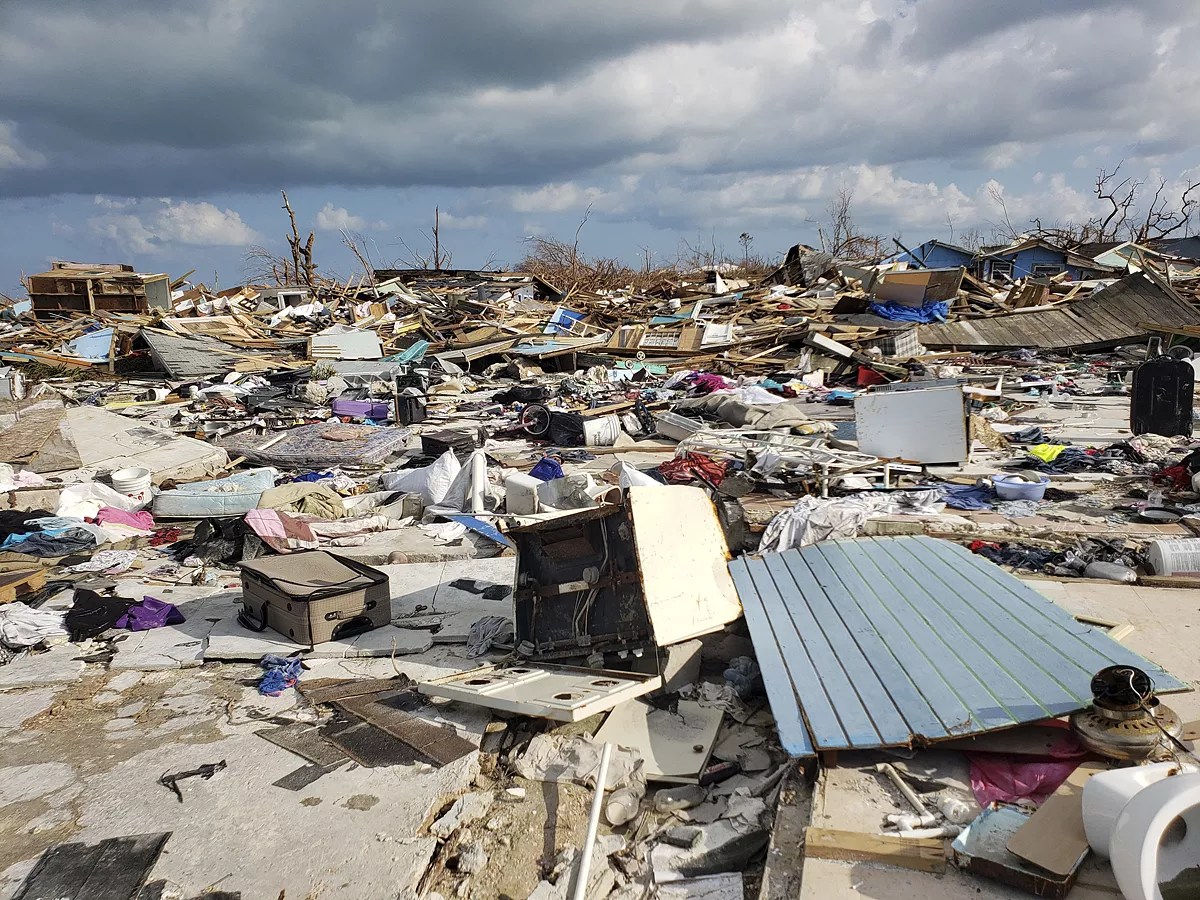
Devastation in the Mudd, a mostly Haitian shantytown. See more photos of the destruction on the Abaco Islands after Hurricane Dorian here.
Photo by Zachary Fagenson
The ground floors of three waterside villas had been washed away, leaving what remained of the structures partially collapsed and pancaked onto their foundations. I deposited some supplies in a room whose door frame had been blown off to who-knew-where; then I went back out to find Pasteur.
He drove us to a large pink health clinic that was serving as a shelter, but armed troops wouldn’t allow us inside. Farther down the road, we came upon a three-story government complex overflowing with partially clothed people, most of them Hatians, whose homes had been swept away. They said the police had stopped by the prior evening and told them to leave, likely owing to sanitation concerns stemming from a lack of power.
“Three or four police officers came in the middle of the night and said, ‘Y’all are too nasty. You can’t stay here. This is a government building. You have to get out,'” 38-year-old Andreuse George-Louise recounted.
George-Louise told me she was born in Haiti but had lived in the Bahamas for more than two decades. Two years ago, she moved to Nassau from the island of Bimini hoping to find work as a housekeeper. Before the storm, she said, she’d been living on Great Abaco in the large shantytown known as the Mudd, which Dorian had all but obliterated.
“We have nothing now. We lost everything,” she said. “And now they’re telling people who were saved by God, who saw their families die, to go sleep in the bush?”
A ten-minute trek up the road revealed what was left of the Mudd. Shacks were split apart, spilling their contents onto the waterlogged earth. The ground was littered with clothing, children’s bicycles, shredded suitcases, mattresses, tools, books, family photos, and dislodged toilets and appliances. Crumpled cars were piled together like balled-up waste paper. On the roof of a silver sedan lay the carcass of a dog, its mouth ajar, its eyes already decaying.
Armed with our cameras, my fellow journalists and I trudged through the killing field, looking for the perfect image to capture the tragedy. A pair of drones buzzed overhead.
“It would pick up something and throw it at us — like it was saying, ‘If you come out here, all of you are dead.’ ”
My reverie was broken by the sight of a wild pig that emerged from the rubble and charged in my direction. A swing of my backpack didn’t deter it, but a group of men in a passing Geo Prizm with blown-out windows paused to holler at the beast, and it changed course.
A few minutes later, a lone Bahamian in a sagging pickup drove by, staring me down as he passed. Twenty yards farther along, I heard his brakes screech and his car flip into reverse.
“You guys need to get out of here,” he said to me and my two colleagues. What followed was a diatribe about how this vast expanse of stinking refuse should have never existed.
“These people moved here, illegally coming to this country, and within two days they illegally build a shack house, and this shouldn’t be,” the 37-year-old contractor, Topeto Davis, fumed. “We’ve been having this problem for years. If you look at this death count in this country, 90 percent of the people who died live here, and they should have never been here to begin with.”
Davis was not expressing an uncommon sentiment. In annihilating Great Abaco, Dorian exposed the tensions that have simmered between native Bahamians and Haitian immigrants who began coming to the island in the ’60s to escape François “Papa Doc” Duvalier’s murderous reign.
In 1963, the Haitian community accounted for 3.2 percent of the nation’s population. By 2009, that figure had more than tripled, to 11.1 percent, according to an estimate from the Bahamian Department of Statistics. In recent years, the country has tightened its immigration laws, targeting migrants from Jamaica and Cuba in addition to those from Haiti; since 2015, all residents have been required to carry a passport. Prior to the storm, the government had set a deadline of July 31, 2019, to evacuate those living in the Abacos’ six shantytowns.
“They’re robbing regular folks; they’re robbing the people who have money; they’re looting and grabbing everything they can,” said Davis, echoing sentiments that flooded social media in the Bahamas in Dorian’s wake.
As night fell, the pickup that was supposed to shuttle us back to the hotel failed to materialize. The three of us caught a ride back to Marsh Harbour with an assistant commissioner of the Royal Bahamas Police Force. Without electricity, it was impossible to locate the room where I’d stowed my gear. The telltale groan of a generator led us to a shack occupied by five cooks from chef José Andrés’ World Central Kitchen, who were making plans for the following day and insisted on feeding us dinner.
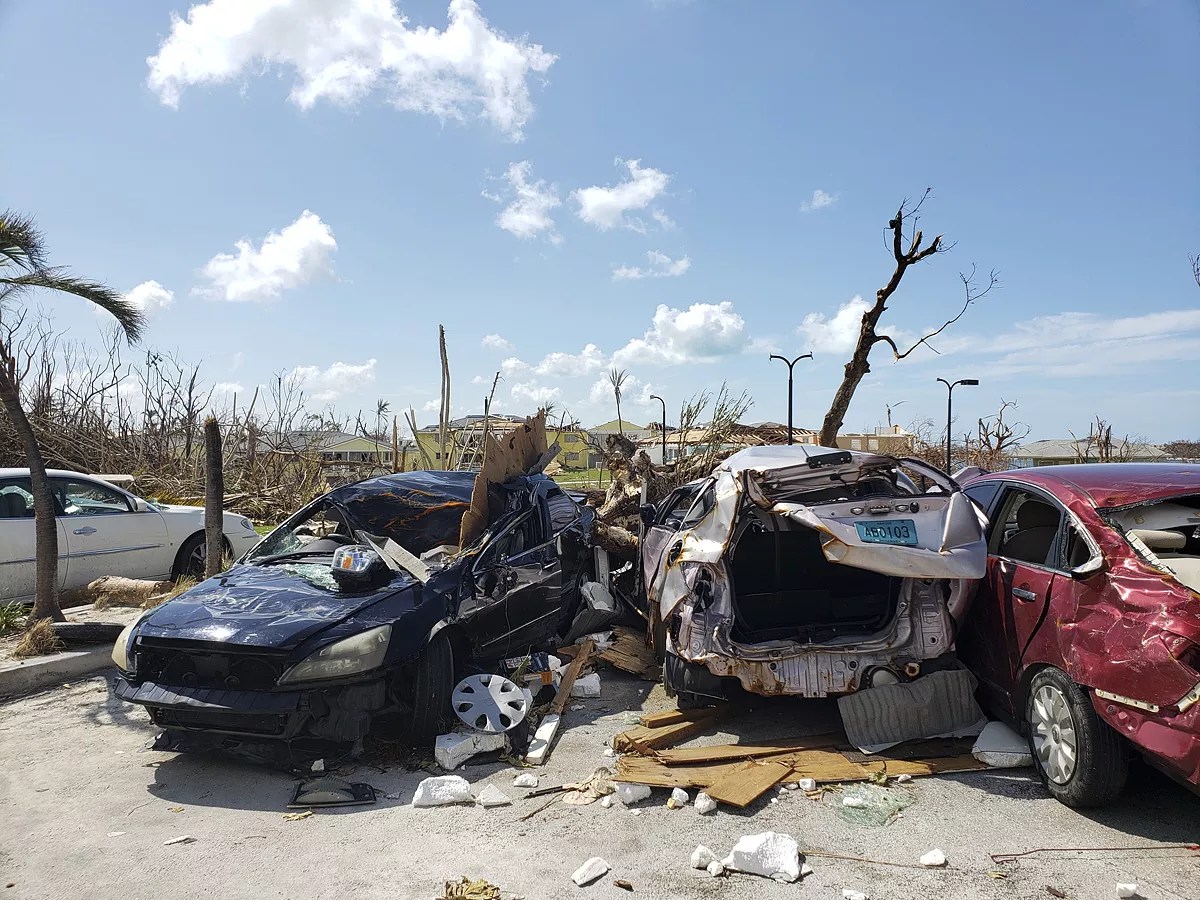
Crushed cars on the edge of the mostly Haitian shantytown called the Mudd. See more photos of the destruction on the Abaco Islands after Hurricane Dorian here.
Photo by Zachary Fagenson
As we set off again in search of our room, we encountered more hospitality – this time from a team of paramedics who beckoned us aboard the lone boat bobbing in the marina, offering air-conditioned comfort and outlets to recharge our dying phones and laptops.
“We were at the airport earlier today,” Mark Glicksman, a volunteer paramedic from the Israeli nonprofit United Hatzalah, told me. “Cleveland Clinic was there, Florida Task Force was there, a bunch of people were there. But everyone looked around and didn’t see anything to do, so they left.
“These organizations are coming in and the government is clearing them, but there’s nothing else,” he continued. “They’re providing their own logistics and having to figure out where to go themselves. This is five or six days old – there should’ve been someone there coordinating security, coordinating food, coordinating flights or boat rides off the island. Someone should be organizing search-and-rescue. We know there are still people out there.”
After the generator clicked off and the boat became a sauna below deck, we all went up to sleep under the stars.
I don’t believe I’ve ever eaten a meal that nourished the body and spirit as thoroughly as that sweet beef stew and carrots, served over mashed potatoes. Same goes for the ice-cold beers the paramedics pressed upon us.
But no amount of food and drink could stave off the disorientation brought on by enjoying First-World comforts amid a shattered hellscape.
We rose at dawn to head northwest out of Marsh Harbour with a driver from the Royal Bahamas Police Force and two of the Hatzalah paramedics. Even as the density of homes waned, the destruction persisted. Roads had only recently been cleared, bulldozers had yet to sweep away the nests of tangled power lines that had a nasty habit of wrapping themselves in the axles of passing cars and creating 2,000-pound roadblocks. Side roads were flooded or clogged with debris. Here and there, a person would appear in the doorway of a faraway house on top of a seemingly inaccessible hill and give a curt wave.
After a while, the paramedics decided anyplace was a good place to stop. We got out and began knocking on doors.
Despite the deathly silence, the area was not abandoned. Many residents had returned to their homes to dig out what clothing and furniture they could, hoping to stave off mildew in case they could move in again. In some instances, the storm had done the work, dislodging doors and blowing the entire contents of a house onto the street. The people we spoke with said they’d seen no one going house-to-house, no aid workers, no one from the government since the storm had passed through more than a week earlier.
“You’re the first ones we’ve seen come around,” Roseline Valiant said. “We need medication. We need clothes. We need water. We need everything to start all over. It’s like being born again.”
Valiant, who’s 57, said she flies back and forth to Miami to restock her small clothing boutique in Marsh Harbour. Now, though, the store was missing part of its roof, and half of her house was flooded. She and her two children had taken refuge in the living room, which now was crammed with all of their belongings, along with what she had salvaged from her inventory, hoping to dry it out.
Down the road at the Soul Saving Ministry, Pastor Lawrence Arnett warned that we hadn’t seen the worst of the damage, which lay just over the hill on which Valiant’s house was built. It took us half an hour to locate a passable route, plus another ten minutes to free a terrified dog chained to a fence.
From the top of the hill, we could see the sparkling turquoise sea that a few days earlier had leveled the land below us. Overhead, military helicopters churned. All that remained of the houses that led down to the water were cinder-block skeletons or heaps of rubble resting on concrete pads. In the distance, a generator whirred. A family of six, mostly adults, peeked out from their front door and gave a cautious smile and a wave.
“We’ve seen nobody, and we need help,” 38-year-old Louinoi Louincee said. The shoe shop owner’s front yard was covered in neat rows of sneakers and high heels she hoped she might still be able to sell. “The first day after the storm, we walked up to Marsh Harbour for supplies, but we haven’t been able to get back. There’s no food, no water, and no fuel. We’re stuck.”
The paramedics asked whether anyone required medical attention. No, they all said. Louincee’s brother and her father popped open a can of Vienna sausages and began to debate who would hike to town and how much water they could carry back.
Midday brought radio calls that search-and-rescue teams were converging on the island’s other large shantytown, Pigeon Peas, to look for human remains. Over the course of the morning, it had become clear there was little rescuing to be done. Most of the critically injured, along with children and pregnant women, had been evacuated by U.S. Coast Guard helicopter days earlier. All that was left to do was find the dead.
As we made our way back to Marsh Harbour, the sour smell of death surrounded us. We stopped frequently, lifting sheets of plywood and twisted mattresses to see what might lie beneath.
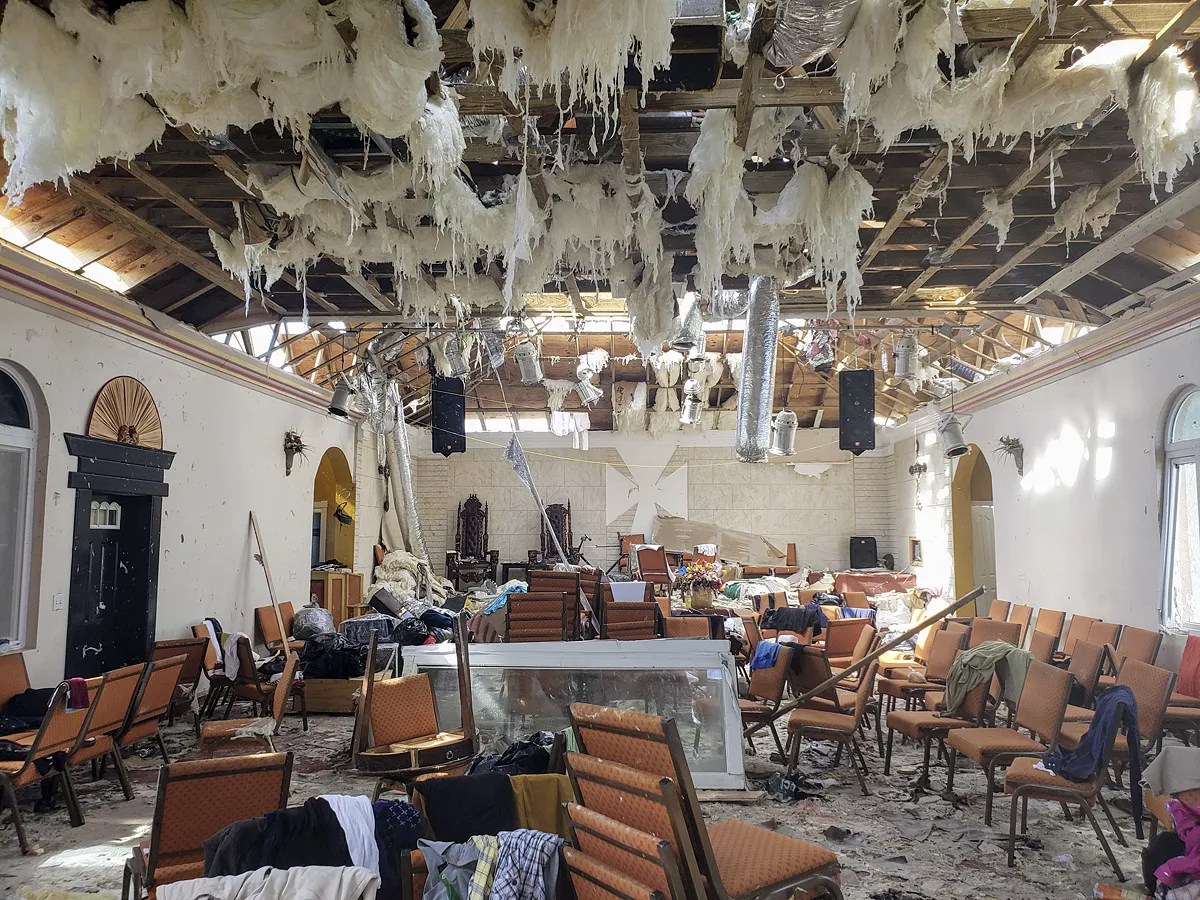
A destroyed church in Dundas Town, near Marsh Harbour. See more photos of the destruction on the Abaco Islands after Hurricane Dorian here.
Photo by Zachary Fagenson
We chanced upon a small crew of firefighters from North Florida slowly making their way through a small field of tall matted grass. They weilded metal poles that looked like fireplace pokers, which they used to lever up nail-studded slabs of plywood. For now, they could do little beyond scanning the surface of the field of debris. Peeling away the ten-foot-high piles of wreckage would have to wait for the arrival of heavy equipment.
“A local said it best when he expressed a lot of gratitude from the people who live here who did lose loved ones and will be able to have some kind of closure after their loved ones’ remains are found,” said Chad Belger, a 38-year-old lieutenant from the Gainesville Fire Department who’s a member of one of Florida’s volunteer emergency task forces.
Government workers clad in disposable hazmat suits, rubber boots, and masks carried a body bag out of a teal building.
“The devastation here is unbelievable,” Joe Colon, a retired Green Beret, said when the crew broke for lunch. “I’ve been deployed to Iraq and Afghanistan, and this looks worse. This looks like they threw a couple of bombs here, gathered up all the stuff, and threw another bomb on top of it.”
A Navy SEAL who introduced himself as Richard Graham had brought along a German shepherd named Mika who was indicating so many potential bodies it was almost impossible for Graham to discern where they were.
In total, the team marked three more bodies: a man who’d been crushed between two shanties; a woman in purple-flowered pants lying facedown in the muck; and a victim tangled in chicken wire. A thin piece of plywood was laid atop each, and the locations were marked with orange spray paint and tagged with GPS waypoints that would be passed along to recovery crews that would return the next day.
Given the extent of the damage, Belger said, there could be weeks of work ahead. “You just have to pick a spot and move out from there.”
As I write this, few news cameras remain on Great Abaco, even as an estimated 1.5 billion pounds of storm debris rots in Marsh Harbour. The Miami Herald no longer publishes daily updates about the aftermath; the last story Reuters ran was dated September 15.
So many of Abaco’s residents have fled the destruction that the government closed its main shelter there.
As of presstime, the death toll stands at 56 – the same as it has been since September 21. The number of missing stands at 692, down from the 2,500 the government announced earlier in September and a figure many are taking as a proxy for the actual death toll.
“World Central Kitchen has established a kitchen on Abaco, and we are uniquely committed to serving fresh food to those in need,” the organization’s executive director, Nate Mook, wrote in an email. “We will continue to provide hot meals as long as we are needed.”
Bahamian Prime Minister Hubert Minnis has announced the creation of the Ministry of Disaster Preparedness, Management, and Reconstruction to oversee the effort. Minnis designated Grand Bahama and the Abacos as Economic Recovery Zones for a minimum of three years. “This designation will allow communities affected by Hurricane Dorian to benefit from a wide range of fiscal incentives,” Minnis said during a news conference.
The truth is no one knows how long it will take to rebuild the crushed islands. But the people who lived there are determined to do so.
Before I left Abaco, I met Carrington George Woodside, the owner of a port security company. He was trying to get one of his pickup trucks to start so he could drive to the police station to offer his assistance.
“Help is what we need – a lot of help,” he said. “We need our electricity back; we need generators; we need our water system. And people need food and drinks across the island, not just Marsh Harbour.
“We can’t give up on this island,” he added. “This place is everything to us: our home, our culture, our souls. We will rebuild, and we will come back stronger.”
For information about how to donate to the relief efforts in the Bahamas, please see New Times’ earlier coverage here.